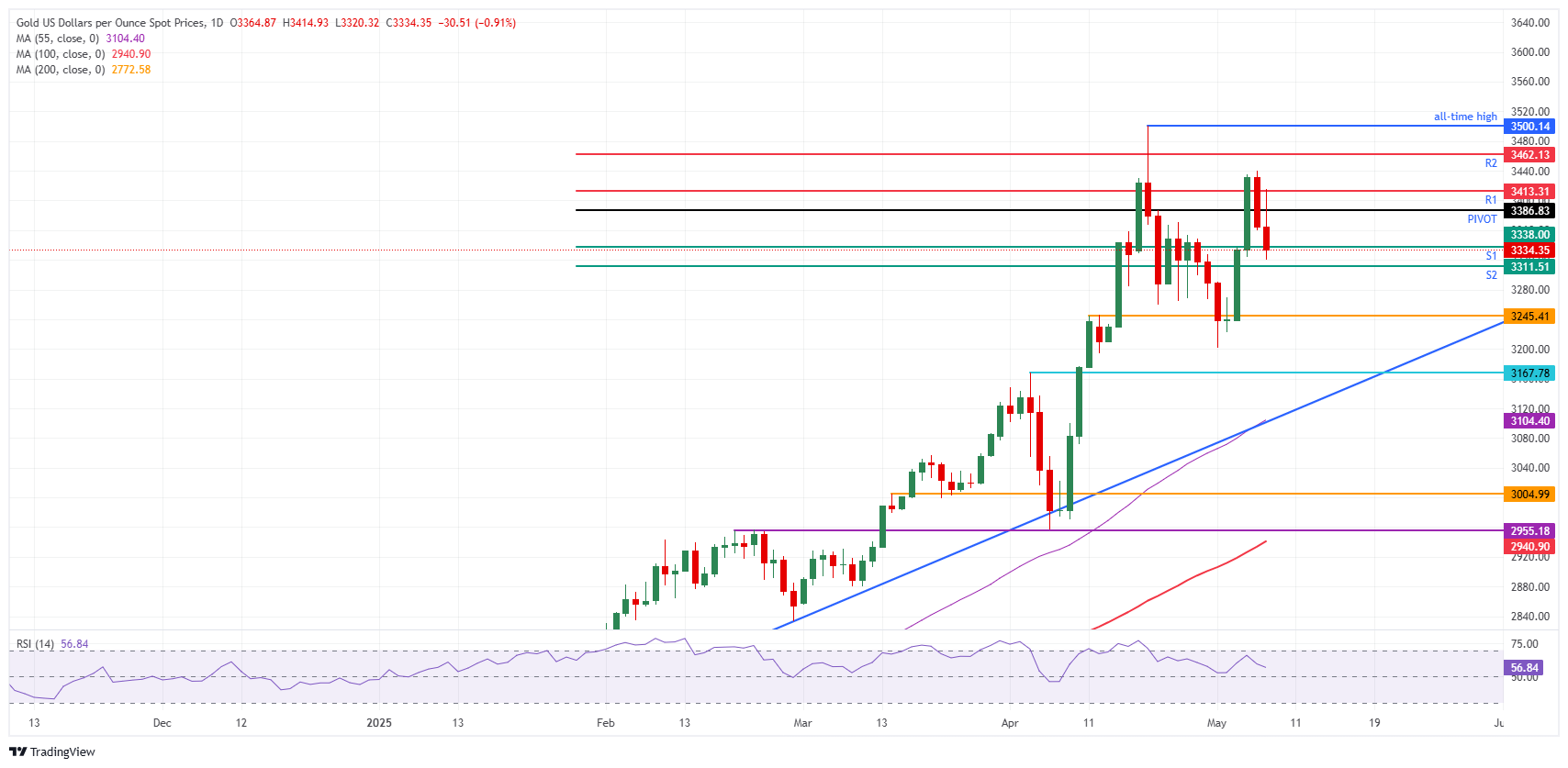Gold price tumbles for second straight day ahead of trade deal announcement
- Gold price extends correction and drops nearly 1% in early European trading on Thursday.
- The UK and the US are ready to announce a trade deal that would circumvent the US tariff implementation.
- Gold sees safe haven outflow with the assumption that more deals will follow suit.
Gold (XAU/USD) extends the prior’s day correction and drops nearly 1% to $3,333 at the time of writing on Thursday as risk sentiment improves, with United States (US) President Donald Trump expected to announce a trade deal agreement with the United Kingdom (UK) at a news conference at 14:00 GMT in Washington, according to people familiar with the matter. Meanwhile, the UK administration has confirmed to Bloomberg and the Financial Times that a deal will be announced. Details on that trade deal remain unconfirmed.
Additional driver overnight was the Federal Reserve (Fed) interest rate decision and Fed Chairman Jerome Powell’s remarks. The main takeaway from Powell’s words was that the US economy is showing signs of resilience for now. However, Powell expects the actual impact of tariffs and heightened uncertainty to impact economic numbers later this year. The central bank kept interest rates unchanged in the range of 4.25%-4.50%, confirming the markets’ assumption, as seen in the Fedwatch Tool, that a rate cut is not foreseen until summer.
Daily digest market movers: Funds not seeing Gold rally done for
- In the Asian trading session, before the trade deal announcement was issued, the Gold price was climbing, after tumbling on Wednesday when the Federal Reserve held interest rates, and Chair Jerome Powell said the central bank isn’t in a rush to cut despite trade-war uncertainty, Bloomberg reports.
- That the Gold Rush is not over, even with a possible initial trade deal, can be seen with statements from several hedge funds. This Thursday, Waratah Capital Advisors Ltd. reported it is betting on Gold to lift its returns this year as investors pile into the asset to shelter their wealth during the global trade war, Bloomberg reports.
- “Big News Conference tomorrow morning at 10:00 EDT (14:00 GMT), The Oval Office, concerning a MAJOR TRADE DEAL WITH REPRESENTATIVES OF A BIG, AND HIGHLY RESPECTED, COUNTRY. THE FIRST OF MANY!!!” President Trump wrote on his social media platform “Truth Social”, The New York Times reports.
Gold Price Technical Analysis: Talks with instantly big questions
Do not pop the champagne just yet with this initial trade deal between the UK and the US. Euphoria is taking place in markets on the back of these headlines, though the first element to trim the ambiance is that the UK is indeed a big economy, though with the near least exposure to the US in terms of trade. That a deal is being struck this quickly means it will probably only be on one segment, or a deal in principle.
Gold price initially traded higher this Thursday, facing rejection at the R1 resistance near $3,413. Should the signing of the deal be delayed, or if the actual deal is really just some window dressing, expect a knee-jerk reaction with Gold quickly sprinting back to that level. Once there, it is not far from the R2 resistance at $3,462.
On the downside, the S1 support at $3,338 is being tested at the time of writing. Further down, the S2 support comes in at $3,311, though technically not holding any other relevance besides being a daily pivotal level. The watchdog level, which is near $3,245, is a much stronger floor from a technical standpoint.

XAU/USD: Daily Chart
Gold FAQs
Gold has played a key role in human’s history as it has been widely used as a store of value and medium of exchange. Currently, apart from its shine and usage for jewelry, the precious metal is widely seen as a safe-haven asset, meaning that it is considered a good investment during turbulent times. Gold is also widely seen as a hedge against inflation and against depreciating currencies as it doesn’t rely on any specific issuer or government.
Central banks are the biggest Gold holders. In their aim to support their currencies in turbulent times, central banks tend to diversify their reserves and buy Gold to improve the perceived strength of the economy and the currency. High Gold reserves can be a source of trust for a country’s solvency. Central banks added 1,136 tonnes of Gold worth around $70 billion to their reserves in 2022, according to data from the World Gold Council. This is the highest yearly purchase since records began. Central banks from emerging economies such as China, India and Turkey are quickly increasing their Gold reserves.
Gold has an inverse correlation with the US Dollar and US Treasuries, which are both major reserve and safe-haven assets. When the Dollar depreciates, Gold tends to rise, enabling investors and central banks to diversify their assets in turbulent times. Gold is also inversely correlated with risk assets. A rally in the stock market tends to weaken Gold price, while sell-offs in riskier markets tend to favor the precious metal.
The price can move due to a wide range of factors. Geopolitical instability or fears of a deep recession can quickly make Gold price escalate due to its safe-haven status. As a yield-less asset, Gold tends to rise with lower interest rates, while higher cost of money usually weighs down on the yellow metal. Still, most moves depend on how the US Dollar (USD) behaves as the asset is priced in dollars (XAU/USD). A strong Dollar tends to keep the price of Gold controlled, whereas a weaker Dollar is likely to push Gold prices up.

